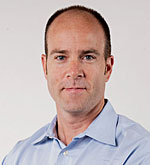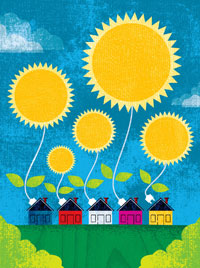sierraclub.org - sierra magazine - jan/feb 2013 - me and my solar
ME AND MY SOLAR
Joining the rooftop solar revolution
By Michael Brune
 Michael Brune, Sierra Club executive director | Photo by Lori Eanes
Michael Brune, Sierra Club executive director | Photo by Lori Eanes
The energy battle is turning. Coal is on its way out, along with the pollution and health problems it causes. The National Renewable Energy Laboratory says that given a more flexible electric system, clean energy could generate
80 percent of America's electricity by 2050. That figure is almost certainly too conservative, because it underestimates the potential of the solar panels that are sprouting on rooftops all across America—including my own.
The dream of generating electricity from sunlight goes way back. "I'd put my money on the sun and solar energy," Thomas Edison told Henry Ford in 1931. "What a source of power! I hope we don't have to wait until oil and coal run out before we tackle that." Nine out of 10 Americans have the same hope—and if you asked Sierra Club members, it would likely be a Spinal Tap-esque 11 out of 10.
 Illustration by Michael Austin
Illustration by Michael Austin
Solar power is a superstar energy source because, in addition to its being inexhaustible, every kilowatt we generate can replace a kilowatt of dirty energy. Charge an electric vehicle's battery with solar and you take oil out of the mix completely.
There are two approaches to producing power from sunlight. One is to build a giant solar plant somewhere reliably sunny—the desert Southwest, for instance. That power gets distributed in the same way as power from a coal- or nuclear-fired plant. Utilities are comfortable with this centralized solar model because it's familiar, predictable, and efficient. Last year in California alone, utility-scale solar plants hit 1 gigawatt—as much power as is generated by two large gas-fired power plants.
At the same time, photovoltaic panels on California rooftops—including the new array on my family's roof—were producing 1.2 gigawatts. This approach is called "distributed generation," because power is fed to the grid from many places at once. Large-scale, centralized solar plants are like giant mainframe computers, while local, rooftop solar is like a million laptops connected to the Internet. What's exciting about distributed solar is that it empowers individuals—in this case, literally. Until recently, though, those individuals had to be homeowners who could afford a big investment that might take years to recoup.
Best of all, we're doing our part to build a clean-energy economy.
Fortunately, smart business innovations are making distributed solar available to millions more people. One is a new kind of financing called a solar lease. My family's lease means that we'll have clean energy for the next 20 years at a locked-in, reasonable rate and that the leasing company will handle any maintenance (although solar systems don't require much, since they have no moving parts). We got ours through one of the Club's Solar Homes partners, Sungevity, though there are many similar companies.
Best of all, we know we're doing our part to move beyond dirty energy and to build a clean-energy economy. My family's contribution might seem small, but if you multiply it by the millions of homes in the United States that could also be miniature clean-energy power plants, the potential benefits add up quickly.
And soon you won't even have to be a homeowner to take advantage of local distributed solar power. Community-shared solar arrays, known as "solar gardens," will let you join with your neighbors to lower your electricity bills while helping the planet. Companies like Mosaic allow people to pool their resources and "crowd fund" solar projects—all while receiving a return on their investment.
The big question is whether our electric utilities can "think different" and embrace distributed solar, just as they've learned to include utility-scale solar and wind. As Sierra reports in "Solar for All," some relatively simple changes could vastly increase the amount of solar power generated. The computer industry faced a similar challenge years ago and made the right choice by pushing the PC. The sooner the electric utility industry wakes up to the potential for personal energy, the better for us all.
Michael Brune is the executive director of the Sierra Club. You can e-mail him at michael.brune@sierraclub.org and follow him on Twitter and Facebook.